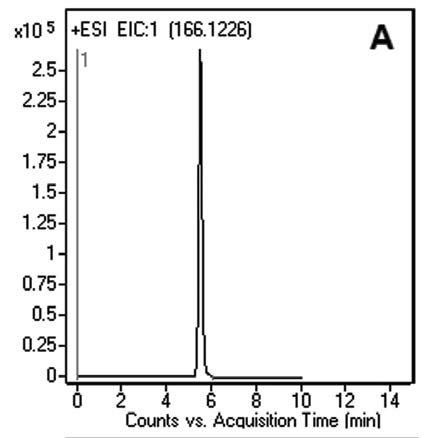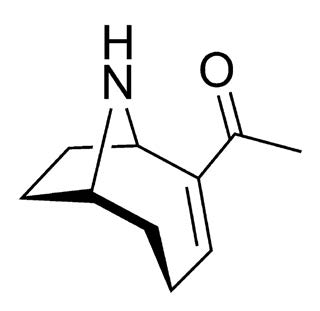Anatoxin-a Analyzed with LCMS
Figures below illustrate an example of the work flow in developing a Method for the Analysis of a Polar Compound using Cogent Diamond Hydride™ Columns and the impact of Aqueous Normal Phase HPLC.
The simplified steps of Method Development are as follows:
—A. Injection of the Sample at 50:50 Solvent A / Solvent B Mobile Phase Composition results in Figure A. In this case, Anatoxin-a has considerable retention.
—B. Injection of the Sample at 40:60 Solvent A / Solvent B Mobile Phase Composition results in Figure B. As expected, the Retention of Anatoxin-a is longer and the Peak Shape is broader with higher organic content.
—C. Based on the above results, a simple Linear Gradient is designed to achieve the desired Retention of the Compound and excellent Peak Shape (Figure C). If shorter Retention time is desired it can be accomplished by changing the starting concentration of Solvent B to 60%, designing a steeper gradient, or using a shorter Column such as 2.1 x 50mm.
Peak:
Anatoxin-a, 166.1226 m/z (M+H)+
Method Conditions
Column: Cogent Diamond Hydride™, 4μm, 100Å
Catalog No.: 70000-15P-2
Dimensions: 2.1 x 150mm
Mobile Phase:
—A: 50% Methanol / 50% DI Water / 0.1% Formic Acid
—B: Acetonitrile / 0.1% Formic Acid
Gradient:
| Time (minutes) | %B |
| 0 | 70 |
| 5 | 30 |
| 6 | 30 |
| 7 | 70 |
Temperature: 25˚C
Post time: 5 minutes
Injection vol.: 1μL
Flow rate: 0.4mL / minute
Detection: ESI – POS – Agilent 6210 MSD TOF Mass Spectrometer
t0: 0.9 minutes
Note: Anatoxin-a (ANTX-A) is a cyanobacterial neurotoxin, implicated in many animal and human poisoning incidents. ANTX-A blocks neurotransmission causing death by respiratory arrest. The presence of this toxin in freshwater has to be monitored in order to prevent fatalities.
Attachment
No 142 Method Development Strategy for Polar Compounds pdf 0.3 Mb Download File






